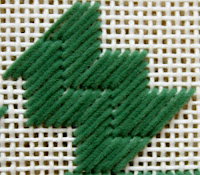
The Oblique Slav seems like it would be a breeze to do but sometimes the easiest stitches can turn out to be more of a challenge than originally anticipated. This was the case with the Oblique Slav. Stitchers attending the "Stitch of the Week" class eventually got the hang of this stitch and I even saw one apply it right away to a project that she was working on -- so the message is persevere!
The Oblique Slav is a satin or straight stitch that goes down two horizontal canvas threads and to the left over four vertical canvas threads. The next stitch begins two canvas threads to the right of where you began the first stitch and again you go down two horizontal canvas threads and to the left four vertical canvas threads. The row of stitches begins at the left and proceeds toward the right. When you reach the end of the row and you want to return in the other direction, drop down two horizontal canvas threads beneath where you
began the last stitch of the previous row. Come forward in this hole and go up two horizontal canvas threads and to the right four vertical canvas threads.
To summarize: when you are working a row of Oblique Slav stitches from left to right, you will begin your stitches at the top of each stitch (and go down two and to the left four) whereas when you are working a row of stitches from right to left you will begin your stitches at the bottom (and go up two and to the right four). This will provide the maximum amount of thread coverage on the backside of the canvas which will help to compensate for the fact that the Oblique Slav is not a stitch with good backing.

The Oblique Slav is a great stitch for imitating crown molding or decorative trim on clothing. Suzanne Howren and Beth Robertson in their wonderful book,
Stitches for Effect, recommend using ribbon-type threads for this stitch such as Neon Rays and Shimmer Blend RibbonFloss. Be sure to use a laying tool when working with ribbon-type threads in order to prevent unsightly twisting. Howren and Robertson also suggest using stranded cotton or silk thread (at Rittenhouse Needlepoint these include Embroidery Floss, Splendor or Mandarin Floss).

A most attractive variation on this stitch is two work it diagonally in stripes with different colored threads. Do the first stitch up two horizontal canvas threads and to the right four vertical canvas threads. Begin the second stitch two horizontal canvas threads below and two vertical canvas threads to the left of where you
began stitch number one. This "down 2 and to the left 2, then up two and to the right four" procedure is repeated until you reach the bottom of the available space where you will end your thread. Start the next row at the top with a new color.
When the area is completed, fill in the empty spaces at the edge with tent stitches. In general, it is always a good idea to leave compensation for last -- that way you are less likely to get confused especially when you first start working the stitch. Also, be sure not to pull too tightly as this stitch tends to pull the canvas out of shape.

 small stitch that fits well into small areas and is relatively simple to compensate. The stitch is especially effective in two different colors and/or types of threads.
small stitch that fits well into small areas and is relatively simple to compensate. The stitch is especially effective in two different colors and/or types of threads. The stitch is a two-step process. The first step consists of a series of mosaic stitches but instead of having the Mosaic stitches slant up and to the right these mosaic stitches slant up and to the left. A single canvas thread is skipped in-between these "reverse" mosaic stitches.
The stitch is a two-step process. The first step consists of a series of mosaic stitches but instead of having the Mosaic stitches slant up and to the right these mosaic stitches slant up and to the left. A single canvas thread is skipped in-between these "reverse" mosaic stitches.

























